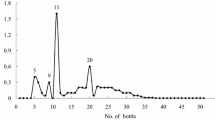Abstract
A toxin produced by a deleterious rhizobacterial pseudomonad that inhibits both winter wheat (Triticum aestivum L.) root andEscherichia coli growth was characterized. The toxin was rapidly deactivated at pH 2 and 12 and by autoclaving (121°C, 15 minutes). Less toxin was destroyed as the temperature and time of exposure decreased, and at 40°C it was stable for at least 24 hours. The toxin was extremely polar and could not be extracted from culture filtrates with organic solvents. The compound eluted after the void volume from a Sephadex G-10 column indicating a molecular weight of less than 700. The toxin adsorbed to Dowex 50W strong cation exchange resin and eluted with 2M NH4OH. Numerous thin layer chromatography solvent systems were unsuccessful at purifying the toxin. The partially purified toxin inhibited several different microorganisms while the producing strains were resistant. The toxin appears unique to toxins produced by recognized plant pathogenic bacteria.
Similar content being viewed by others
References
Braun A C 1955 A study on the mode of action of the wildfire toxin. Phytopathology 45, 659–664.
Bolton Jr H and Elliott L F 1989 Toxin production by a rhizobacterialPseudomonas sp. that inhibits wheat root growth. Plant and Soil 114, 269–278.
DeVay J E, Lukezic F L, Sinden S L, English H and Coplin D L 1968 A brocide produced by pathogenic isolates ofPseudomonas syringae and its possible role in the bacterial canker disease of peach trees. Phytopathology 58, 95–107.
Elliott L F and Lynch J M 1984 Pseudomonads as a factor in the growth of winter wheat (Triticum aestivum L.). Soil Biol. Biochem. 16, 69–72.
Elliott L F and Lynch J M 1985 Plant growth inhibitory pseudomonads colonizing winter wheat (Triticum aestivum L.) roots. Plant and Soil 84, 57–65.
Fredrickson J K and Elliott L F 1985a Colonization of winter wheat roots by inhibitory rhizobacteria. Soil Sci. Soc. Am. J. 49, 1172–1177.
Fredrickson J K and Elliott L F 1985b Effects on winter wheat seedling growth by toxin producing rhizobacteria. Plant and Soil 83, 399–409.
Fredrickson J K, Elliott L F and Engibous J C 1987 Crop residues as substrate for host specific inhibitory pseudomonads. Soil Biol. Biochem. 19, 127–134.
Gasson M J 1980 Indicator technique for antimetabolite toxin production by phytopathogenic species ofPseudomonas. Appl. Environ. Microbiol. 39, 25–29.
Hoitink H A J, Pelletier J G and Coulson J G 1966 toxemia of halo blight of beans, Phytopathology 56, 1062–1065.
Marconi G G 1975 Silica gel chromatography of antibotics.In Antibiotics. Methods in Enzymology, Vol. 43. Ed. J H Hash. pp 291–296. Academic Press, New York.
Mitchell R E 1976 Isolation and structure of a chlorosis inducing toxin ofPseudomonas phaseolicola. Phytochemistry 15, 1941–1947.
Mitchell R E 1981 Structure: bacterial.In Toxins in Plant Disease. Ed. R D Durbin. pp 259–293. Academic Press, New York.
Mitchell R E and Durbin R D 1981 Tagetitoxin, a toxin produced byPseudomonas syringae pv.tagitis: Purification and partial characterization. Physiol. Plant Pathol. 18, 157–168.
Palleroni N J, Kunisawa R, Contopoulou R and Doudoroff M 1973 Nucleic acid homologies in the genusPseudomonas. Int. J. Syst. Bacteriol. 23, 333–339.
Papendick R I and Miller D E 1977 Conservation tillage in the Pacific Northwest. J. Soil Water Conserv. 32, 49–56.
Pharmacia 1981 Gel filtration theory and practice. Pharmacia Fine Chemical. Uppsala, Sweden. Rahms i Lund, Sweden.
Rudolph K and Rasche E 1981 Purification of the clorosis inducing toxin fromPseudomonas phaseolicola (Burch) Dowson. Phytopathol. Z. 101, 298–313.
Schroth M N, Hildebrand D C and Starr M P 1981 Phytopathogenic members of the genusPseudomonas.In The Prokaryotes: A Handbook on Habitats, Isolation and Identification of Bacteria. Eds. M P Starr, H Stolp, H G Truper, A Balows and H G Schlegel, pp 701–718. Springer-Verlag, Berlin.
Shaad N W 1980 Laboratory Guide for Identification of Plant Pathogenic Bacteria. Amer. Phytopathol. Soc., St. Paul, Minesota.
Shaw P D 1981 Production and isolation.In Toxins in Plant Disease. Ed. R D Durbin, pp 21–44. Academic Press, New York.
Sinden S L, DeVay J E and Backman P A 1971 Properties of syringomycin, a wide spectrum antibiotic and phytotoxin produced byPseudomonas syringae and its role in the bacterial canker disease of peach trees. Physiol. Plant Pathol. 1, 199–213.
Sinden S L and Durbin R D 1969 Some comparisons of chlorosis inducing pseudomonad toxins. Phytopathology 59, 249–250.
Staskawicz B J and Panopoulos N J 1979 A rapid and sensitive microbiological assay for phaseolotoxin. Phytopathology 69, 663–666.
Steel R G D and Torrie J H 1980 Principles and Procedures of Statistics. A Biometrical Approach. 2nd ed. McGraw Hill Book Co., New York.
Stewart W W 1971 Isolation and proof of structure of wildfore toxin. Nature 229, 174–178.
Stroo H F, Elliott L F and Papendick R I 1988 Growth, survival and toxin production of root-inhibitory pseudomonods on crop residues. Soil Biol. Biochem. 20, 201–207.
Suslow T V and Schroth M N 1982 Role of deleterious rhiobacteria as minor pathogens in reducing crop growth. Phytopathology 72, 111–115.
Woolley D W, Pringle R B and Braun A C 1952 Isolation of the phytopathogenic toxin ofPseudomonas tabaci an antagonist of methionine. J. Biol. Chem. 197, 409–417.
Author information
Authors and Affiliations
Additional information
Contribution from the Agric. Res. Serv., U.S. Dept. of Agriculture in cooperation with the College of Agric. and Home Econ., Res. Ctr., Washington State University, Pullman, WA 99164, USA
Rights and permissions
About this article
Cite this article
Bolton, H., Elliott, L.F., Gurusiddaiah, S. et al. Characterization of a toxin produced by a rhizobacterialPseudomonas sp. that inhibits wheat growth. Plant Soil 114, 279–287 (1989). https://doi.org/10.1007/BF02220808
Received:
Revised:
Issue Date:
DOI: https://doi.org/10.1007/BF02220808




